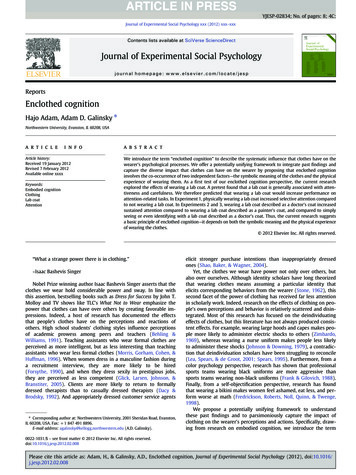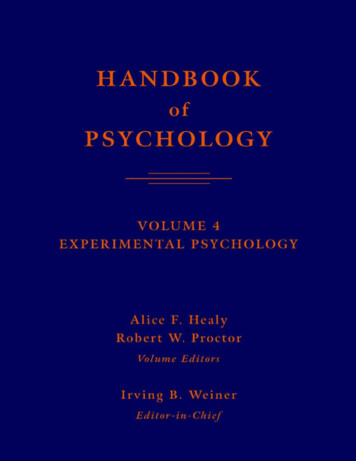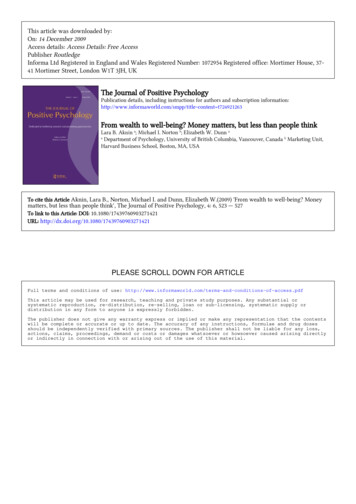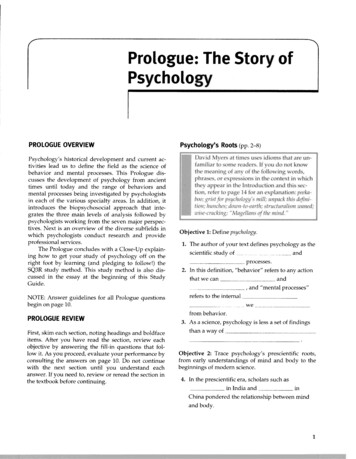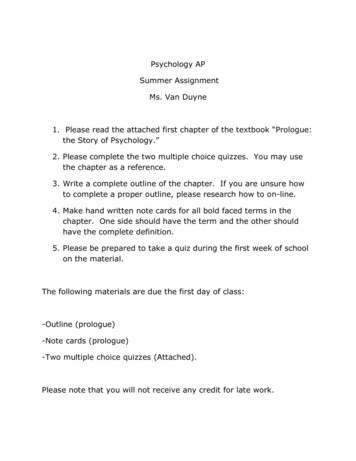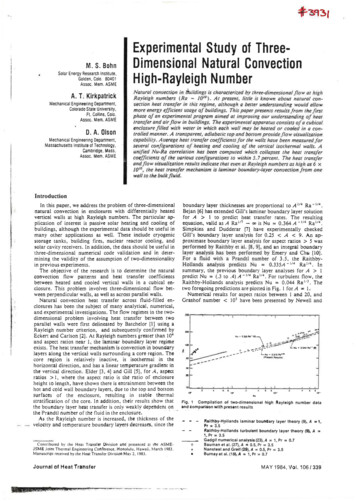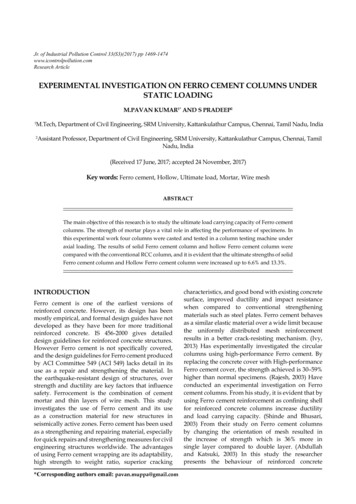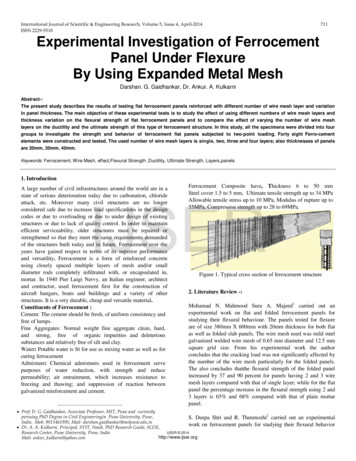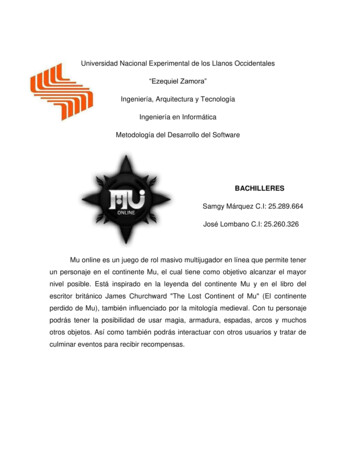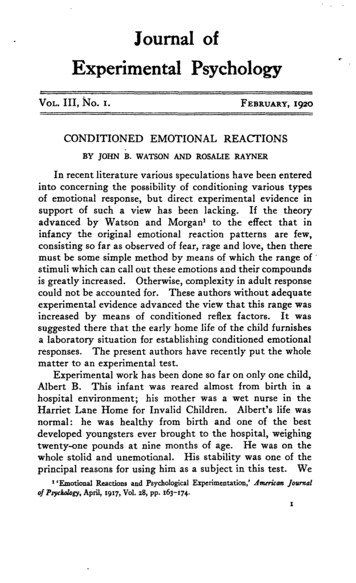
Transcription
Journal ofExperimental PsychologyVOL. Ill, No. i.FEBRUARY, 1920CONDITIONED EMOTIONAL REACTIONSBY JOHN B. WATSON AND ROSALIE RAYNERIn recent literature various speculations have been enteredinto concerning the possibility of conditioning various typesof emotional response, but direct experimental evidence insupport of such a view has been lacking. If the theoryadvanced by Watson and Morgan1 to the effect that ininfancy the original emotional reaction patterns are few,consisting so far as observed of fear, rage and love, then theremust be some simple method by means of which the range ofstimuli which can call out these emotions and their compoundsis greatly increased. Otherwise, complexity in adult responsecould not be accounted for. These authors without adequateexperimental evidence advanced the view that this range wasincreased by means of conditioned reflex factors. It wassuggested there that the early home life of the child furnishesa laboratory situation for establishing conditioned emotionalresponses. The present authors have recently put the wholematter to an experimental test.Experimental work has been done so far on only one child,Albert B. This infant was reared almost from birth in ahospital environment; his mother was a wet nurse in theHarriet Lane Home for Invalid Children. Albert's life wasnormal: he was healthy from birth and one of the bestdeveloped youngsters ever brought to the hospital, weighingtwenty-one pounds at nine months of age. He was on thewhole stolid and unemotional. His stability was one of theprincipal reasons for using him as a subject in this test. We1'Emotional Reactions and Psychological Experimentation,' American Journalof Psychology, April, 1917, Vol. 28, pp. 163-174.
3JOHN B. WATSON AND ROSALIE RAYNERfelt that we could do him relatively little harm by carryingout such experiments as those outlined below.At approximately nine months of age we ran him throughthe emotional tests that have become a part of our regularroutine in determining whether fear reactions can be calledout by other stimuli than sharp noises and the sudden removalof support. Tests of this type have been described by thesenior author in another place.1 In brief, the infant wasconfronted suddenly and for the first time successively witha white rat, a rabbit, a dog, a monkey, with masks withand without hair, cotton wool, burning newspapers, etc. Apermanent record of Albert's reactions to these objects andsituations has been preserved in a motion picture study.Manipulation was the most usual reaction called out. Atno time did this infant ever show fear in any situation. Theseexperimental records were confirmed by the casual observations of the mother and hospital attendants. No one hadever seen him in a state of fear and rage. The infant practically never cried.Up to approximately nine months of age we had not testedhim with loud sounds. The test to determine whether afear reaction could be called out by a loud sound was madewhen he was eight months, twenty-six days of age. Thesound was that made by striking a hammer upon a suspendedsteel bar four feet in length and three-fourths of an inch indiameter. The laboratory notes are as follows:One of the two experimenters caused the child toturn its head and fixate her moving hand; the other,stationed back of the child, struck the steel bar a sharpblow. The child started violently, his breathing waschecked and the arms were raised in a characteristicmanner. On the second stimulation the same thing occurred, and in addition the lips began to pucker andtremble. On the third stimulation the child broke intoa sudden crying fit. This is the first time an emotionalsituation in the laboratory has produced any fear or evencrying in Albert.1'Psychology from the Standpoint of a Behaviorist,' p. 202.
CONDITIONAL EMOTIONAL REACTIONS3We had expected just these results on account of our workwith other infants brought up under similar conditions. Itis worth while to call attention to the fact that removal ofsupport (dropping and jerking the blanket upon which theinfant was lying) was tried exhaustively upon this infant onthe same occasion. It was not effective in producing thefear response. This stimulus is effective in younger children.At what age such stimuli lose their potency in producingfear is not known. Nor is it known whether less placid childrenever lose their fear of them. This probably depends upon thetraining the child gets. It is well known that children eagerlyrun to be tossed into the air and caught. On the other handit is equally well known that in the adult fear responses arecalled out quite clearly by the sudden removal of support,if the individual is walking across a bridge, walking out upona beam, etc. There is a wide field of study here which isaside from our present point.The sound stimulus, thus, at nine months of age, gives usthe means of testing several important factors. I. Can wecondition fear of an animal, e.g., a white rat, by visuallypresenting it and simultaneously striking a steel bar? II. Ifsuch a conditioned emotional response can be established,will there be a transfer to other animals or other objects?III. What is the effect of time upon such conditioned emotional responses ? IV. If after a reasonable period such emotional responses have not died out, what laboratory methodscan be devised for their removal ?I. The establishment of conditioned emotional responses.At first there was considerable hesitation upon our part inmaking the attempt to set up fear reactions experimentally.A certain responsibility attaches to such a procedure. Wedecided finally to make the attempt, comforting ourselvesby the reflection that such attachments would arise anywayas soon .as the child left the sheltered environment of thenursery for the rough and tumble of the home. We did notbegin this work until Albert was eleven months, three daysof age. Before attempting to set up a conditioned responsewe, as before, put him through all of the regular emotional
4JOHN B. WATSON AND ROSALIE RAYNERtests. Not the slightest sign of a fear response was obtained inany situation.The steps taken to condition emotional responses areshown in our laboratory notes.II Months 3 Days1. White rat suddenly taken from the basket andpresented to Albert. He began to reach for rat with lefthand. Just as his hand touched the animal the bar wasstruck immediately behind his head. The infant jumpedviolently and fell forward, burying his face in the mattress. He did not cry, however.2. Just as the right hand touched the rat the bar wasagain struck. Again the infant jumped violently, fellforward and began to whimper.In order not to disturb the child too seriously nofurther tests were given for one week.II Months IO Days1. Rat presented suddenly without sound. Therewas steady fixation but no tendency at first to reach forit. The rat was then placed nearer, whereupon tentativereaching movements began with the right hand. Whenthe rat nosed the infant's left hand, the hand was immediately withdrawn. He started to reach for the headof the animal with the forefinger of the left hand, butwithdrew it suddenly before contact. It is thus seenthat the two joint stimulations given the previous weekwere not without effect. He was tested with his blocksimmediately afterwards to see if they shared in theprocess of conditioning. He began immediately to pickthem up, dropping them, pounding them, etc. In theremainder of the tests the blocks were given frequentlyto quiet him and to test his general emotional state.They were always removed from sight when the processof conditioning was under way.2. Joint stimulation with rat and sound. Started,then fell over immediately to right side. No crying.
CONDITIONAL EMOTIONAL REACTIONS53. Joint stimulation. Fell to right side and restedupon hands, with head turned away from rat. No crying.4. Joint stimulation. Same reaction.5. Rat suddenly presented alone. Puckered face*whimpered and withdrew body sharply to the left.6. Joint stimulation. Fell over immediately to rightside and began to whimper.7. Joint stimulation. Started violently and cried,but did not fall over.8. Rat alone. The instant the rat was shown thebaby began to cry. Almost instantly he turned sharplyto the left, fell over on left side, raised himself on all foursand began to crawl away so rapidly that he was caught withdifficulty before reaching the edge of the table.This was as convincing a case of a completely conditionedfear response as could have been theoretically pictured.In all seven joint stimulations were given to bring about thecomplete reaction. It is not unlikely had the sound beenof greater intensity or of a more complex clang characterthat the number of joint stimulations might have beenmaterially reduced. Experiments designed to define thenature of the sounds that will serve best as emotional stimuliare under way.II. When a conditioned emotional response has beenestablished for one object, is there a transfer? Five dayslater Albert was again brought back into the laboratory andtested as follows:11 Months 75 Days1. Tested first with blocks. He reached readily forthem, playing with them as usual. This shows thatthere has been no general transfer to the room, table,blocks, etc.2. Rat alone. Whimpered immediately, withdrewright hand and turned head and trunk away.3. Blocks again offered. Played readily with them,smiling and gurgling.
JOHN B. WATSON AND ROSALIE kAYNER4. Rat alone. Leaned over to the left side as faraway from the rat as possible, then fell over, getting upon all fours and scurrying away as rapidly as possible.5. Blocks again offered. Reached immediately forthem, smiling and laughing as before.The above preliminary test shows that the conditioned response to the rat had carried over completelyfor the five days in which no tests were given. Thequestion as to whether or not there is a transfer wasnext taken up.6. Rabbit alone. The rabbit was suddenly placedon the mattress in front of him. The reaction was pronounced. Negative responses began at once. He leanedas far away from the animal as possible, whimpered,then burst into tears. When the rabbit was placed incontact with him he buried his face in the mattress,then got up on all fours and crawled away, crying as hewent. This was a most convincing test.7. The blocks were next given him, after an interval.He played with them as before. It was observed byfour people that he played far more energetically withthem than ever before. The blocks were raised highover his head and slammed down with a great deal offorce.8. Dog alone. The dog did not produce as violent areaction as the rabbit. The moment fixation occurredthe child shrank back and as the animal came nearer heattempted to get on all fours but did not cry at first.As soon as the dog passed out of his range of vision hebecame quiet. The dog was then made to approach theinfant's head (he was lying down at the moment).Albert straightened up immediately, fell over to theopposite side and turned his head away. He then beganto cry.9. The blocks were again presented. He began immediately to play with them.10. Fur coat (seal). Withdrew immediately to theleft side and began to fret. Coat put close to him on the
CONDITIONAL EMOTIONAL REACTIONS7left side, he turned immediately, began to cry and triedto crawl away on all fours.u . Cottonwool. The wool was presented in a paperpackage. At the end the cotton was not covered by thepaper. It was placed first on his feet. He kicked itaway but did not touch it with his hands. When hishand was laid on the wool he immediately withdrew itbut did not show the shock that the animals or furcoat produced in him. He then began to play with thepaper, avoiding contact with the wool itself. He finally,under the impulse of the manipulative instinct, lostsome of his negativism to the wool.12. Just in play W. put his head down to see ifAlbert would play with his hair. Albert was completelynegative. Two other observers did the same thing.He began immediately to play with their hair. W.then brought the Santa Claus mask and presented it toAlbert. He was again pronouncedly negative.II Months 20 Days1. Blocks alone. Played with them as usual.2. Rat alone. Withdrawal of the whole body, bending over to left side, no crying. Fixation and followingwith eyes. The response was much less marked than onfirst presentation the previous week. It was thought bestto freshen up the reaction by another joint stimulation.3. Just as the rat was placed on his hand the rodwas struck. Reaction violent4. Rat alone. Fell over at once to left side. Reaction practically as strong as on former occasion butno crying.5. Rat alone. Fell over to left side, got up on allfours and started to crawl away. On this occasion therewas no crying, but strange to say, as he started awayhe began to gurgle and coo, even while leaning far overto the left side to avoid the rat.6. Rabbit alone. Leaned over to left side as faras possible. Did not fall over. Began to whimper butreaction not so violent as on former occasions.
JOHN B. WATSON AND ROSALIE RAYNER7. Blocks again offered. He reached for them immediately and began to play.All of the tests so far discussed were carried out upona table supplied with a mattress, located in a small,well-lighted dark-room. We wished to test next whetherconditioned fear responses so set up would appear ifthe situation were markedly altered. We thought itbest before making this test to freshen the reaction bothto the rabbit and to the dog by showing them at themoment the steel bar was struck. It will be recalledthat this was the first time any effort had been made todirectly condition response to the dog and rabbit. Theexperimental notes are as follows:8. The rabbit at first was given alone. The reactionwas exactly as given in test (6) above. When the rabbitwas left on Albert's knees for a long time he begantentatively to reach out and manipulate its fur with forefingers. Whil
Experimental Psychology VOL. Ill, No. i. FEBRUARY, 1920 CONDITIONED EMOTIONAL REACTIONS BY JOHN B. WATSON AND ROSALIE RAYNER In recent literature various speculations have been entered into concerning the possibility of conditioning various types of emotional response, but direct experimental evidence in support of such a view has been lacking. If the theory advanced by Watson
